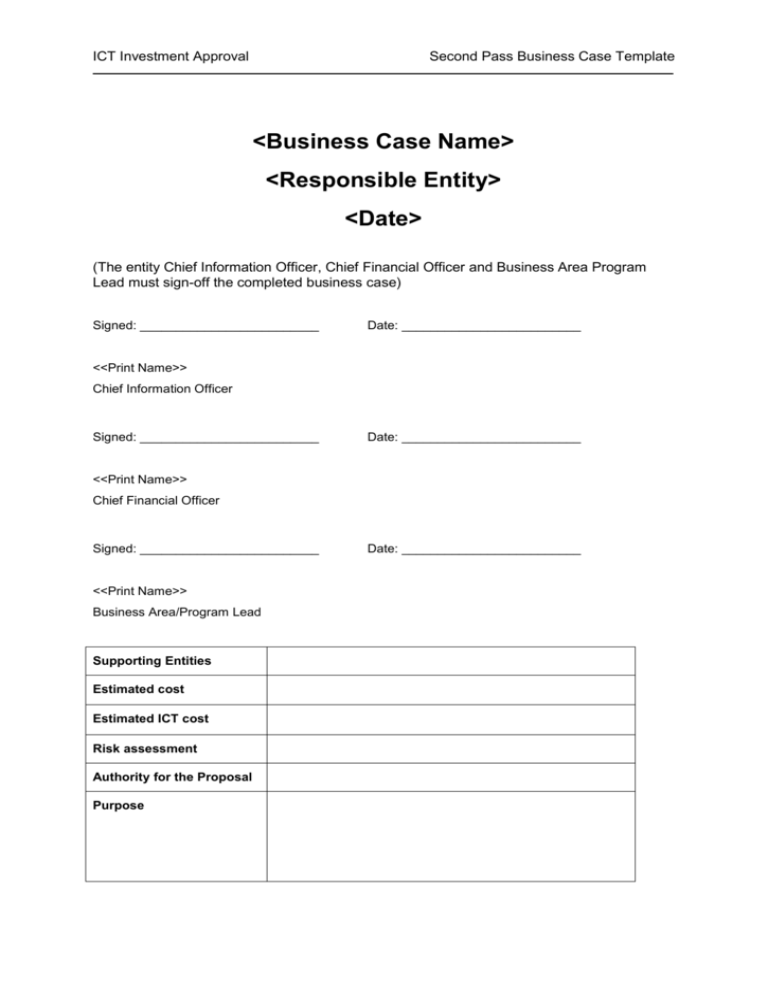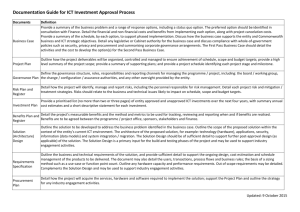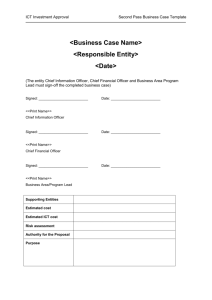2. Summary of First Pass Business Case
advertisement

ICT Investment Approval Second Pass Business Case Template <Business Case Name> <Responsible Entity> <Date> (The entity Chief Information Officer, Chief Financial Officer and Business Area Program Lead must sign-off the completed business case) Signed: _________________________ Date: _________________________ <<Print Name>> Chief Information Officer Signed: _________________________ Date: _________________________ <<Print Name>> Chief Financial Officer Signed: _________________________ <<Print Name>> Business Area/Program Lead Supporting Entities Estimated cost Estimated ICT cost Risk assessment Authority for the Proposal Purpose Date: _________________________ ICT Investment Approval Process Second Pass Business Case Contents 1. Executive Summary ....................................................................................................... 4 1.1 2. Recommendations .................................................................................................. 4 Summary of First Pass Business Case .......................................................................... 4 2.1 Policy Context ......................................................................................................... 4 2.2 Business Problem ................................................................................................... 4 2.2.1 3. 4. Proposed Response ........................................................................................ 4 2.3 Outcome of First Pass ............................................................................................ 4 2.4 Changes since First Pass ....................................................................................... 5 Options Analysis ............................................................................................................ 5 3.1 Options Summary ................................................................................................... 5 3.2 Cost-Benefit Analysis .............................................................................................. 6 3.3 Conclusion .............................................................................................................. 6 Implementation Approach .............................................................................................. 6 4.1 Technical Design Report ......................................................................................... 7 4.2 Entity Capability Impacts for this Option .................................................................. 7 4.3 Project/Program Plan .............................................................................................. 7 4.4 Governance and Control ......................................................................................... 7 4.5 Review Points ......................................................................................................... 7 4.6 Risk Analysis .......................................................................................................... 7 4.7 Benefits Realisation Plan ........................................................................................ 7 4.8 Procurement Plan ................................................................................................... 7 4.9 Cyber Security Policy .............................................................................................. 7 4.10 Organisational Change Plan ................................................................................... 7 4.11 Human Resource Plan ............................................................................................ 7 Detailed Costing ......................................................................................................... 7 4.12 ................................................................................................................................... 7 5. Supporting Documentation ............................................................................................. 7 5.1 Work Breakdown Structure (WBS) Cost Model and Estimate Project Management Plan 8 5.2 Project Management Plan ....................................................................................... 8 5.3 Risk Management Plan ........................................................................................... 8 5.4 Risk Register .......................................................................................................... 8 5.5 Benefits Management Plan ..................................................................................... 8 Page |2 ICT Investment Approval Process Second Pass Business Case 5.6 Solution (Architecture Design) ................................................................................ 8 5.7 Requirements Specification (Business Process Model) .......................................... 8 Entity Quality Plan ...................................................................................................... 8 5.8 ..................................................................................................................................... 8 5.9 Procurement Strategy ............................................................................................. 8 5.10 Governance Plan .................................................................................................... 8 5.11 Change Management Plan ..................................................................................... 8 5.12 Training Plan........................................................................................................... 8 Page |3 ICT Investment Approval Process Second Pass Business Case 1. Executive Summary A key consideration in the development of the Second Pass Business Case is the question of complexity. Several factors contribute to the complexity of a proposal, the degree of change proposed, the number of required components in the proposed solution, the range of cross entity and cross government interaction required, the dollar value, technical complexity and novelty and so on. In determining the complexity of a proposal – and therefore the range and level of detail of information required in the business case, keep in mind that the business case needs to provide information sufficient for the decision being sought. 1.1 Recommendations 2. Summary of First Pass Business Case Much of the material that makes up the background for the Second Pass Business Case may be drawn from the First Pass. As is the case all through the Second Pass Business Case, Second Pass should provide additional, more detailed or updated information. 2.1 Policy Context 2.2 Business Problem Consider using visual representations of Blueprints, Visions or Strategic Intention for the proposal where possible. 2.2.1 Proposed Response Consider using visual representations of Blueprints, Visions or Strategic Intention for the proposal where possible. 2.3 Outcome of First Pass Provide a statement of the outcome of the first pass Cabinet endorsement, including: section of options for second pass review; caveats; deviations from initial proposals; and additional functions required. Page |4 ICT Investment Approval Process Second Pass Business Case 2.4 Changes since First Pass Provide a brief summary of key developments in the organisation, policy space or broader government context since the approval of First Pass, as well as providing an overview of the work undertaken to produce this Second Pass Case. 3. Options Analysis The Options Analysis section is one where additional information may be required based on the relative complexity of the proposal. Consider add more detailed information about cost drivers, costing approaches and included a more detailed description of the costing model. Consideration may also be given to third party verification of the costing model and any assumptions made during the development of the costing. 3.1 Options Summary Where more than one option is being proposed for consideration, a comparative table contrasting the options may be useful. Table 1 – Options Summary Option One Option Two Option N Benefits The quantifiable business benefits that are expected to be realised for each option from the successful delivery of the outcome. These should be categorised as either financial or nonfinancial benefits. Disadvantages A disadvantage is an outcome perceived as negative by one or more stakeholders. Disadvantages are actual consequences of an activity (whereas, by definition, a risk has some uncertainty about whether it will materialise). Timescale What is the overall timeframe for implementation? Over what period will the project costs be incurred? Over what period will the benefits be realised? Cost Summarise the costs (derived from Project Details and Plans below) and the supporting assumptions, including contingencies for risks. The aggregated costs shown here should also include details of the ongoing operational and maintenance costs, and their funding arrangements. Factor in the cost of periodic security assessments and any decommissioning of systems and asset disposal. Detailed costing information should be provided in attachments. Major Risks Provide a summary of the aggregated risk ratings, highlighting the major risks and their possible effect on the business objectives and benefits (therefore, covering both the project delivery and the ongoing operations and maintenance). Page |5 ICT Investment Approval Process Second Pass Business Case 3.2 Cost-Benefit Analysis 3.3 Conclusion 4. Implementation Approach Proposal complexity may have an impact on the range of implementation approaches available for consideration. In-house against outsourced, phased implementation against ‘bigbang’ change approach, incremental improvement against wholesale innovation will be informed by the complexity of the proposal. As with funding, the degree of detail provided in the implementation approach should be commensurate with the complexity of the proposal. Additional consideration should also be given to the implications that each delivery option has on the surrounding organisational environment. Include in your business case a description of the mechanisms in place to ensure that delivery is co-ordinated, not only within the context of the current proposal, but also with other initiatives underway in the entity, and where relevant with broader cross-entity, inter-entity and whole of government initiatives. Page |6 ICT Investment Approval Process Second Pass Business Case 4.1 Technical Design Report Include High level Business Process Model, and ICT Architecture diagrams, in the document – and provide more detailed versions of these models and architectures as attachments. 4.2 Entity Capability Impacts for this Option 4.3 Project/Program Plan 4.4 Governance and Control 4.5 Review Points 4.6 Risk Analysis 4.7 Benefits Realisation Plan 4.8 Procurement Plan 4.9 Cyber Security Policy 4.10 Organisational Change Plan 4.11 Human Resource Plan 4.12 Detailed Costing 5. Supporting Documentation This is a list of potential supporting documentation that may be relevant to a specific business case. The list is not intended to be exhaustive, and there may be more or fewer attachments depending on the nature of the proposal. Refer to the ICT Investment Approval process Documentation Guide for details. Page |7 ICT Investment Approval Process Second Pass Business Case 5.1 Work Breakdown Structure (WBS) Cost Model and Estimate Project Management Plan 5.2 Project Management Plan 5.3 Risk Management Plan 5.4 Risk Register 5.5 Benefits Management Plan 5.6 Solution (Architecture Design) 5.7 Requirements Specification (Business Process Model) 5.8 Entity Quality Plan 5.9 Procurement Strategy 5.10 Governance Plan 5.11 Change Management Plan 5.12 Training Plan Page |8








